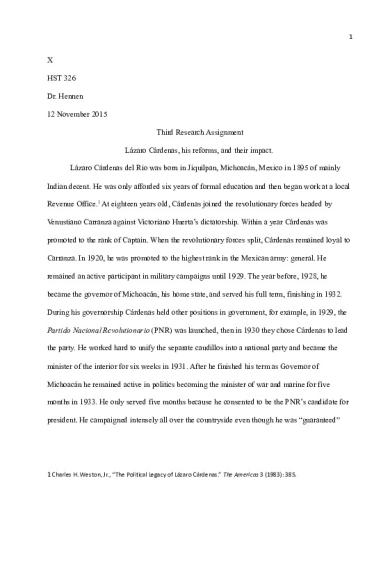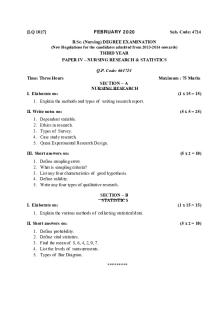HST 326 - Third Research Assignment - Lázaro Cárdenas, his reforms, and their impact PDF

| Title | HST 326 - Third Research Assignment - Lázaro Cárdenas, his reforms, and their impact |
|---|---|
| Author | Jessica Asbury |
| Course | Latin American History |
| Institution | Morehead State University |
| Pages | 6 |
| File Size | 117.7 KB |
| File Type | |
| Total Downloads | 60 |
| Total Views | 136 |
Summary
Paper about Lázaro Cárdenas, his reforms, and their impact...
Description
1
X HST 326 Dr. Hennen 12 November 2015 Third Research Assignment Lázaro Cárdenas, his reforms, and their impact. Lázaro Cárdenas del Rio was born in Jiquilpan, Michoacán, Mexico in 1895 of mainly Indian decent. He was only afforded six years of formal education and then began work at a local Revenue Office.1 At eighteen years old, Cárdenas joined the revolutionary forces headed by Venustiano Carranza against Victoriano Huerta’s dictatorship. Within a year Cárdenas was promoted to the rank of Captain. When the revolutionary forces split, Cárdenas remained loyal to Carranza. In 1920, he was promoted to the highest rank in the Mexican army: general. He remained an active participant in military campaigns until 1929. The year before, 1928, he became the governor of Michoacán, his home state, and served his full term, finishing in 1932. During his governorship Cárdenas held other positions in government, for example, in 1929, the Partido Nacional Revolutionario (PNR) was launched, then in 1930 they chose Cárdenas to lead the party. He worked hard to unify the separate caudillos into a national party and became the minister of the interior for six weeks in 1931. After he finished his term as Governor of Michoacán he remained active in politics becoming the minister of war and marine for five months in 1933. He only served five months because he consented to be the PNR’s candidate for president. He campaigned intensely all over the countryside even though he was “guaranteed”
1 Charles H. Weston, Jr., “The Political Legacy of Lázaro Cárdenas.” The Americas 3 (1983): 385.
2
the position.23 When he was elected president he instituted many reforms such as land, labor, and economic reforms which were and continue to be controversial topics as well as their impact. As president, Lázaro Cárdenas believed that redistribution of land to the poorer people was of utmost importance. During his presidency, around 45 million acres of land was confiscated and given to the peasantry of almost twelve thousand villages.45 With this land the villages were able to build schools, had access to medical care, and other services that improved the standard of living “if only modestly.”6 There were three methods of land distribution: ranchos, cooperative farms, and, most common, ejidos. These ejidos were communal lands shared by the town in small lots but could not be sold or mortgaged, only inherited.7 This was not a new idea, after the conquest of the Americas by the Spanish and Portuguese, they set up similar systems to keep the natives in their places.8 This land distribution virtually wiped out the old hacienda system and created anger and hatred toward Cárdenas within the growing urban middle class and small landowners.9 Another problem with this was the peasants were becoming increasingly dependent on the social services they were receiving. Cárdenas instituted educational reforms to go along with these new schools. Villages were able to construct public buildings, such as schools, to better their lives due to the land made available to them. There was rapid expansion of schools across rural Mexico, all teaching a socialist education. The goal was to create a more unified countryside committed to nationalist ideas, “class consciousness, and anticlericalism.” Some embraced this new thought, but others, 2 Alan Knight, “Cárdenas del Río, Lázaro (1895–1970),” Encyclopedia of Latin American History and Culture. 3John Charles Chasteen, Born in Blood and Fire: A Concise History of Latin America (New York: W.W. Norton & Company, 2011), 241. 4 Benjamin Keen, A History of Latin America (Boston: Houghton Mifflin Company, 1992), 284. 5Knight. 6Keen, 284. 7 Daniel Birrichaga, “Ejidos,”Encyclopedia of Latin American History and Culture. 8 Ibid. 9 Albert L. Michaels, “The Crisis of Cardenismo,” Journal of Latin American Studies 1 (1970): 52.
3
like the Catholic Church, were outraged and saw this as an “attack on the church.”10 This new education system would teach topics such as sexual education which many felt was not a topic to teach their children and the church worried for the children’s souls, but promised to work within the law to change the curriculum.11 Many devout Catholic parents boycotted the schools, violence and protests against this socialist education ensued.12 In addition to distributing lands to the less fortunate, Cárdenas also set forth labor reforms. Workers wanted higher wages and better conditions and in 1934 a new labor organization, La Confederación de Trabajadores Mexicanos or de Mexico (CTM), was formed by a young intellectual from Puebla. In 1935, there were 642 strikes, almost twice than the year before.13 Cárdenas believed that the working class had to form a “cohesive political force” in order to survive and later supported the CTM.14 In 1938, Cárdenas decided to create the Partido de la Revolución Mexicana, replacing the PNR, which would be divided into specific interest groups to better represent the needs of each group.15 The four sectors were the peasant, labor, popular, and military sectors. The military sector was later absorbed into the popular sector. Economic reforms were also on President Lázaro Cárdenas’ agenda. He was sensitive to the wishes of the working class, he also supported businesses. He was aware that he could not alienate businesses by giving in to all demands of the working class; when he helped the working class, he also helped industry in some way, appeasing both sides and “industrial capitalism made significant strides” under his watch.16 In 1934, Cárdenas’ government created the Nacional Financiera, a national bank that used funds from the government and given by domestic 10Michaels, 74. 11Ibid., 75. 12 Knight. 13 Keen, 285. 14 Weston, 386. 15 Ibid., 395. 16 Keen, 285.
4
investors to “make industrial loans, finance public welfare projects, and issue its own securities.”17 The struggle between North American and British oil companies and the unions came to a head under Cárdenas’ presidency. The unions struck and legal action ensued, which lead to a decisive move made by Cárdenas on March 18, 1938, he declared all properties owned by foreign companies were being nationalized for the good of the country.18 This caused an uproar because for the first time a “third world” country was controlling one basic sector of the economy. But this was not the first time Cárdenas had nationalized a resource, in 1937 he had nationalized almost all of the railroads in Mexico. There was no controversy during this because most of the railways were falling apart and were not making any money, so no one was outrageously upset.19 For all of the good these reforms accomplished there were problems, setbacks, and structural flaws within each one. Cárdenas’ agrarian reforms provided real social fortification but near the end of his presidency he weakened support for these programs and the peasants suffered. Also the ejido system became a way of controlling the peasantry when it was supposed to empower them and created an even deeper divide between classes. Though the land was distributed many could not afford to keep up the land nor could they acquire a loan through the Banco de Crédito Ejidal. As late as the 1980s there were four million landless rural workers.20 As with the agrarian reforms, the labor reforms had serious structural flaws. The working class were once again inferior to the upper class, the government, and the companies. This also shifted some labor organization leader’s loyalties from their cause to those of the politicians. When Cárdenas
17 Keen, 285. 18 Ibid., 285. 19Clayton R. Koppes, “The Good Neighbor Policy and the Nationalization of Mexican Oil: A Reinterpretation,” The Journal of American History 1 (1982): 65 20 Keen, 285.
5
nationalized the oil this caused great unrest for the United States and Great Britain and interfered with international relations among them. Lázaro Cárdenas’ presidency was extremely influential and its impact can be seen today. Cárdenas created the Partido de la Revolución Mexicana which was transformed in 1946 to the Partido Revolucionario Institucional (PRI). This political party is known for being the most corrupt of all Mexican political parties and still dominates all opposition. It was known that in the Mexican political system the “incumbent chooses his successor,” but Cárdenas helped establish this unwritten rule.21 Cárdenas’ goal was a “worker’s democracy,” giving the working class a voice in their government, but for all the good that his reforms accomplished they only widened the gap between the working and upper classes to a divide that has lasted into the modern era.22 Many believe Lázaro Cárdenas was a national hero; most of the time he was portrayed as a man of the people, such as when he went to many small towns and listened to their problems. Others believe he was just another dictator in Mexico’s long lineage of corruption. In theory, his reforms were great for the country but in practice they did not accomplish their goals. His reforms and his presidency continue to be controversial due to these differing opinions of him; whatever the opinion, Lázaro Cárdenas and his legacy will be remembered for all time.
21 Weston, 399-400. 22 Ibid., 401.
6
Bibliography Birrichaga, Daniel. (2008). Ejidos. In J. Kinsbruner & E. D. Langer (Eds.), Encyclopedia of Latin American History and Culture (2nd ed., Vol. 3, pp. 76-77). Detroit: Charles Scribner's Sons. Chasteen, John Charles. Born in Blood and Fire: A Concise History of Latin America. New York: W.W. Norton & Company, 2011. Keen, Benjamin. A history of Latin America. 1992. Boston: Houghton Mifflin Company. 283286. Knight, Alan. (2008). Cárdenas del Río, Lázaro (1895–1970). In J. Kinsbruner & E. D. Langer (Eds.), Encyclopedia of Latin American History and Culture (2nd ed., Vol. 2, pp. 106109). Detroit: Charles Scribner's Sons. Koppes, Clayton R. “The Good Neighbor Policy and the Nationalization of Mexican Oil: A Reinterpretation.” The Journal of American History. Vol. 69, No. 1 (1982). Pp. 62-81. Michaels, Albert L. “The Crisis of Cardenismo.” Journal of Latin American Studies. Vol. 2, No. 1 (1970). Pp. 51-79. Weston, Jr., Charles H. “The Political Legacy of Lázaro Cárdenas.” The Americas. Vol. 39, No. 3 (1983). Pp. 383-405....
Similar Free PDFs

ESE 326 assignment 3 FL2021
- 2 Pages

Assignment third week 2019
- 6 Pages

HIS 259 Assignment
- 19 Pages

HIS-144-T5 - Assignment
- 3 Pages

Research and Media Assignment #3
- 5 Pages

HW #04 - Third Homework Assignment
- 26 Pages

MKT 425 Third Place Assignment
- 5 Pages

HIS 151 LM 4 Assignment
- 4 Pages
Popular Institutions
- Tinajero National High School - Annex
- Politeknik Caltex Riau
- Yokohama City University
- SGT University
- University of Al-Qadisiyah
- Divine Word College of Vigan
- Techniek College Rotterdam
- Universidade de Santiago
- Universiti Teknologi MARA Cawangan Johor Kampus Pasir Gudang
- Poltekkes Kemenkes Yogyakarta
- Baguio City National High School
- Colegio san marcos
- preparatoria uno
- Centro de Bachillerato Tecnológico Industrial y de Servicios No. 107
- Dalian Maritime University
- Quang Trung Secondary School
- Colegio Tecnológico en Informática
- Corporación Regional de Educación Superior
- Grupo CEDVA
- Dar Al Uloom University
- Centro de Estudios Preuniversitarios de la Universidad Nacional de Ingeniería
- 上智大学
- Aakash International School, Nuna Majara
- San Felipe Neri Catholic School
- Kang Chiao International School - New Taipei City
- Misamis Occidental National High School
- Institución Educativa Escuela Normal Juan Ladrilleros
- Kolehiyo ng Pantukan
- Batanes State College
- Instituto Continental
- Sekolah Menengah Kejuruan Kesehatan Kaltara (Tarakan)
- Colegio de La Inmaculada Concepcion - Cebu







